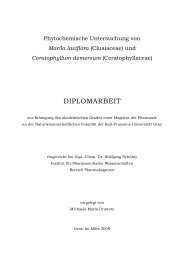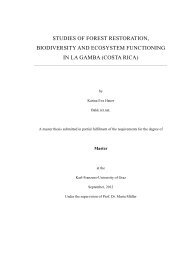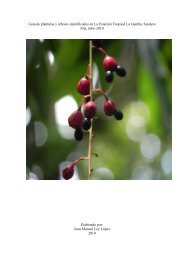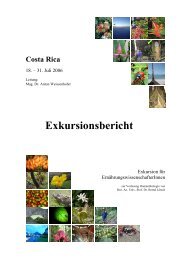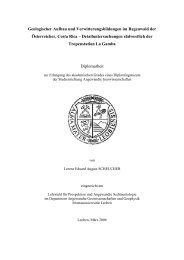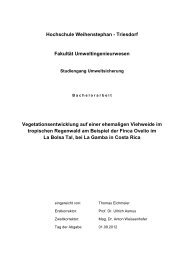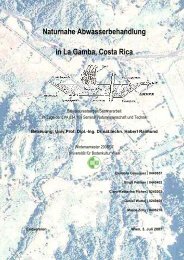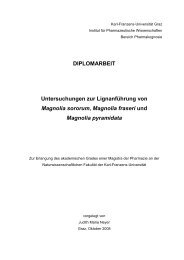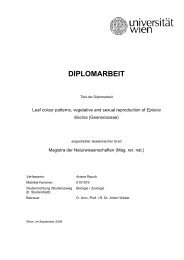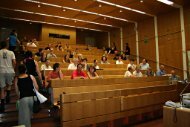Die Tropenstation La Gamba
Die Tropenstation La Gamba
Die Tropenstation La Gamba
Erfolgreiche ePaper selbst erstellen
Machen Sie aus Ihren PDF Publikationen ein blätterbares Flipbook mit unserer einzigartigen Google optimierten e-Paper Software.
<strong>Die</strong> „<strong>Tropenstation</strong> <strong>La</strong> <strong>Gamba</strong>“ in Costa Rica – Wissenschaftlicher Bericht<br />
HÖBEL, G., 1995: Bioakustik des Gladiatorfrosches Hyla rosenbergi. Diplomarbeit:<br />
Univ. Ulm, Inst. f. Zoologie.<br />
In einer sumpfigen Viehweide neben der Biologischen Station <strong>La</strong> <strong>Gamba</strong> wurde die<br />
Fortpflanzungsbiologie von Hyla rosenbergi erforscht. <strong>Die</strong> untersuchte Population wies<br />
eine Reihe von Unterschieden verglichen zu anderen Populationen (Panama) auf, sowohl<br />
in ihrer Größe, ihren Rufen als auch in ihrem Verhalten. <strong>Die</strong> Tiere aus <strong>La</strong> <strong>Gamba</strong> sind<br />
die kleinsten bisher beschriebenen Vertreter der Art. <strong>Die</strong> Männchen rufen aus<br />
wassergefüllten Nestern am Boden, die größtenteils nicht von den Männchen selbst<br />
gebaut werden. Kämpfe zwischen Männchen wurden nie beobachtet, und auch das aus<br />
anderen Populationen beschriebene Bewachen des Geleges durch das Männchen konnte<br />
nicht nachgewiesen werden.<br />
Das akustische Vokabular costaricanischer H. rosenbergi umfasst 5 Ruftypen:<br />
einen Ansageruf, einen Paarungsruf, zwei Territorialrufe und einen Befreiungsruf. Um<br />
die kommunikative Bedeutung dieser Ruftypen zu erforschen wurden Playback-<br />
Experimente mit Männchen und Wahltest mit Weibchen durchgeführt.<br />
HÖBEL, G., 1999: Facultative nest construction in the gladiator frog Hyla rosenbergii<br />
(Anura: Hylidae). - Copeia 3: 797-801.<br />
The egg-laying basins and basin dynamics of the gladiator frog Hyla rosenbergi were<br />
studied in southeastern Costa Rica from May to August 1995. The majority of basins<br />
with calling males inside were water filled puddles or cattle footprints; only 29% of the<br />
basins were male-constructed nests. Basin occupation time was generally short, lasting<br />
on average 1,5 days. Up to two different males used a single basin consecutively, but<br />
proportion of reused basins was very low (15%), which is explained by the night number<br />
of available basins at the study sites.<br />
HÖBEL, G., 2000. Reproductive Ecology of Hyla rosenbergi in Costa Rica.<br />
Herpetologica, 2000, 56(4):446-454.<br />
I studied the calling behavior and reproductive biology of Hyla rosenbergi on the margin<br />
of a swampy cattle pasture in Southeastern Costa Rica. Males had a complex vocal<br />
repertoire with at least five different call types. In contrast with previous studies at other<br />
sites, males in this population showed facultative nest building behavior, did not engage<br />
in violent fights with each other, and did not guard basins, which might be explained by<br />
the abundance of available basin sites. The typical pattern of chorus tenure in H.<br />
rosenbergi was for males to spend only a few nights calling over about a one-week<br />
period. Males occupied 1-10 different nests, and the mean duration of individual nest<br />
occupation was 1.5 days. Individual male mating success was highly skewed; only 34%<br />
of the males managed to obtain a mate. Mating success was positively correlated with<br />
length of residency, chorus tenure, and the number of basins occupied during residency.<br />
Dr. Gerlinde Höbel<br />
Division of Biological Sciences<br />
207 Tucker Hall<br />
Columbia, MO 65211<br />
USA<br />
Phone: (573) 884-8663<br />
Fax: (573) 882-8321<br />
Email: hoebelg@missouri.edu<br />
70



